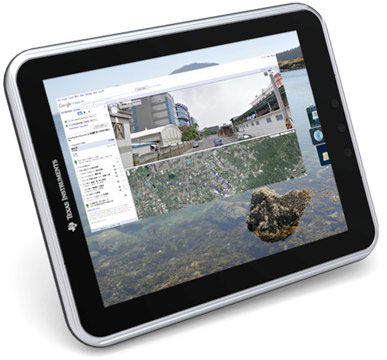Trial tablet
Electronic Contract Manufacturer SVTronics is offering a Texas Instruments Blaze development platform for tablets on its site. It will cost customers $2,259 and is expected to arrive this August. It looks like SVTronics is TI's manufacturing partner for these development platforms.
TI gave HEXUS.channel an introduction to the Blaze development platform for its next generation of SoC - OMAP4 - at this year's Mobile World Congress, but that one was to assist handset development. This is the first time we've seen TI target OMAP4 at the tablet market.
It's hardly a surprise, however, as its ARM-based SoC competitors are already active in that area. The iPad is a huge hit, while Snapdragon and Tegra-based tablets will be with us soon, and Intel's Moorestown will probably be primarily a tablet chip.
We haven't been able to find anything about this tablet platform on TI's website, and we're hoping to speak to TI about this soon. But in the meantime, here's the full feature list and an image, both courtesy of SVTronics.

The Blaze Tablet
- An OMAP4 tablet form factor development platform aligned to the Blaze development platform to maximize SW compatibility
- Allows for cellular modem, WLAN, Bluetooth, GPS and FM connectivity re-configurability using same sockets as Blaze development platform.
- Modularizes the OMAP4430 processor solution which minimizes re-investment for silicon upgrades Supports new feature/application development by allowing the multiple external camera modules and external pico DLP projector to have numerous attachment locations and fields of view
Blaze Tablet features
Core Logic
- OMAP4430 1GHz application and multimedia processor IC
- TWL6030 Phoenix power management IC
- TWL6040 Phoenix audio IC
- CDC3S04 clock driver IC
Memory
- 1 GB lpDDR2
- 32 GB eMMC v4.41
Display
- 10.4" XGA (1024 x 768) LCD
- One (1) standard v1.1a DisplayPort connector
- External pico DLP Projector Support
- HDMI
User Interface
- Projected Capacitance Touch (PCT) sensor
- Multi-touch capable touch screen controller
- Three (3) tri-color status LEDs used as backlight for "OS" buttons
- Two (2) unbalanced mass vibration motors
Buttons and Switches
- One (1) recessed, externally operable reset button
- One (1) power on/off button
- Three (3) front screen "OS" buttons
- One (1) "lock" switch
- One (1) battery mode switch
Serial Interfaces
- One (1) HS USB OTG
- Two (2) HS USB host ports
Removable Media
- One (1) full size 8-bit SD/MMC external connector
- One (1) full size SD/MMC internal connector
- One (1) SIM card for modem support
Audio
- One (1) 3.5 mm stereo headset jack for audio output and MIC input
- Two (2) 1W RMS speakers
- Four (4) digital microphones
Expansion
- One (1) COM connector for connectivity modules
- One (1) full miniPCIe connector for modem modules
Connectivity
- WLAN (802.11a/b/g/n) via WL1283 COM7 module
- BT via WL1283 COM7 module
- GPS via WL1283 COM7 module
- FM TX/RX via WL1283 COM7 module
Modem (Wide Area Network) Support
- LTE modem support via standard miniPCIe module
- 3G modem support via standard miniPCIe module
- To clarify, only one modem can be used at any given moment
Sensors
- 3-axis accelerometer
- 3-axis gyro
- Temperature sensor
- Ambient light sensor
- Proximity sensor
- Pressure (barometric) sensor
- Digital compass
External Camera modules (optional)
- 5MP AF camera modules mounted externally on tablet frame
- The camera module(s) will be connected to the Blaze via standard HDMI cables
- Each OMAP4430 CSI-2 camera interface will have a dedicated HDMI-style connector
Mechanical
- The mechanical envelope, is 10.48" (266.094 mm) x 8.28" (210.294 mm) x 1.14" (29 mm)
- The frame of Blaze Tablet is aluminum
- The frame of the Blaze Tablet will be grooved to allow for external camera module and pico DLP projector attachment
- The attachment system will provide flexibility to the pointing angles of the external camera modules and pico DLP projector
Power
- Support for USB power
- One (1) standard 5V input for wall power
- 4100 mAHr single-cell LiON Battery
Debug
- One (1) 802.3 (wired) Ethernet port (RJ-45 connector)
- One (1) MIPI Test and Debug connector
- One (1) USB connector which has serial (UART) data
- Optional debug LEDs













